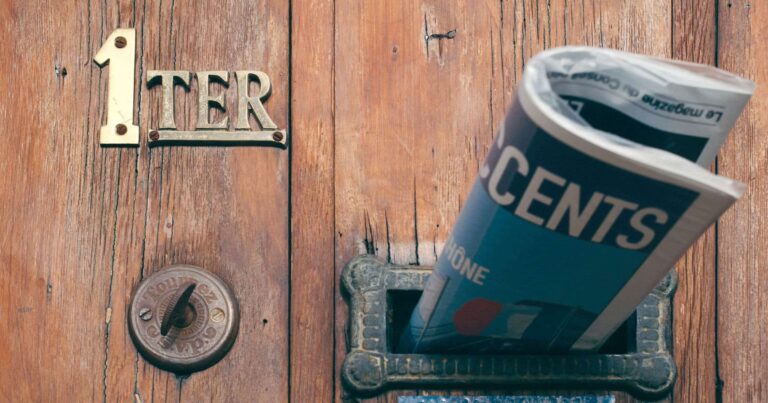Is your newsletter leading people to pay for journalism or a dead end?
We must do a better job of selling journalism. Your livelihood depends on it. My livelihood depends on it. Our communities depend on it.
“But Cory, you say, I’m a [your title here]. I’m not a sales & marketing person.”
I know! That’s why I want to help guide you to an easier road to reach your goals.
Being a journalist in the 21st century is hard. Getting people to pay for journalism in the era of streaming and TikTok and rising rents is damn hard. That’s why it’s important to be good at selling your work. Journalism isn’t going to sell itself.
For a lot of people — the idea that readers should pay for journalism isn’t self-evident. After all, they have been surrounded by reams of free content for a while.
Where did readers get the idea that news should be free?
Back in 2019, I signed up for 99 totally free newsletters. Since then, I’ve subscribed to hundreds more. Didn’t pay one silver dime. I’ve read some interesting stories from all over the country. It’s pretty great.
Additionally, 96 of those original 99 newsletters recommended that I follow them on Facebook, Twitter or Instagram. Those platforms are all free to catch up on news.
To be clear: I’m not saying you shouldn’t use social media. But for many publications, a reader can get enough free information to feel satisfied — from the publication itself!
That’s a lot of news and information. All for free. All from original publishers.
People didn’t dream up the idea that news is cheap. They’ve experienced an all-you-can-eat buffet of free news for more than two decades now.
But we know the real story. Journalism isn’t cheap. It’s an expensive enterprise, and it’s getting harder as a business every year. Ads aren’t bringing in the money they once were, so it’s crucial to persuade people to pay for journalism they enjoy.
The importance of selling your journalism
I love seeing more newsrooms moving toward reader revenue. The hard part is that you can’t flip a switch to make the change. Building loyal audiences takes a different strategy than getting more clicks. You have to change your strategy to connect with people in a different way.
You have to sell the work.
Think of it this way. If a new friend asked you why they should pay for a subscription, would you have some good reasons for them?
Or, have you ever posted a link on Twitter or Facebook asking people to subscribe?
That’s selling your work! The difference is that I don’t want you to ask people to pay for your work. I want you to give them a compelling, persuasive reason to pay for your work.
A lot of journalists see business functions as outside of their responsibility. I’m not saying remove the wall between editorial and business. I’m saying your newsletter can be a great place to sell your work. The Seattle Times found that readers referred by a newsletter are 25x more likely to subscribe than a Facebook referral.
Set ’em up and knock ’em down
Here’s a great email to get inspired by. It’s so good at guiding the reader to where you need them to go. I’ll even give InsideClimate News a pass for violating an important newsletter rule: Don’t use the “Dear Reader” intro.
One thing that makes this so great is it follows an old copywriting rule: What’s the job of the first sentence? To make you read the second sentence. What’s the job of the second sentence? To make you read the third sentence. Check this out:
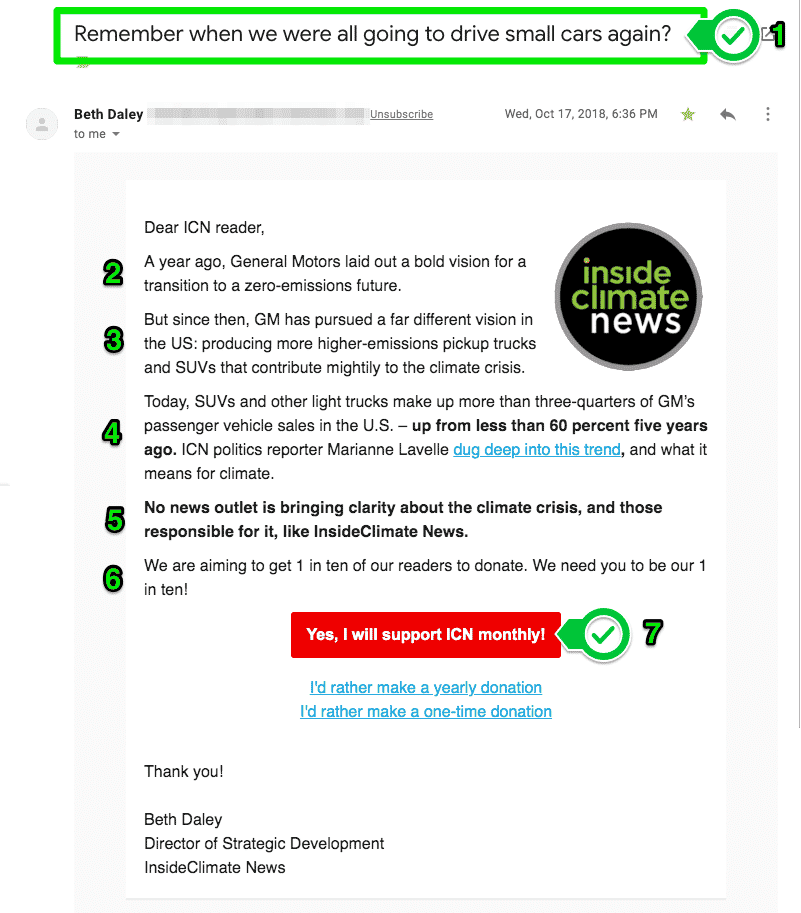
- Chances are ICN readers are more inclined to buy a smaller, more efficient car. This subject line “Remember when we were all going to drive small cars again?” introduces tension between what was supposed to happen — and what is actually happening. Open!
- Email text: “A year ago, General Motors laid out a bold vision for a transition to a zero-emissions future.” You can feel the “but…” coming. This opening sentence gets you to read the next sentence.
- “But since then, GM has pursued a far different vision in the US: producing more higher-emissions pickup trucks and SUVs that contribute mightily to the climate crisis.” General Motors isn’t keeping its promise, and it’s making things worse. How bad is it?
- “Today, SUVs and other light trucks make up more than three-quarters of GM’s passenger vehicle sales in the U.S. – up from less than 60 percent five years ago. ICN politics reporter Marianne Lavelle dug deep into this trend, and what it means for climate.” Here, ICN does two important things: (1) bold the outrage-inducing number and (2) link to their coverage to give more details about what this means. The bold and the link are visual cues.
- “No news outlet is bringing clarity about the climate crisis, and those responsible for it, like InsideClimate News.“ Boom. ICN is telling you that they have your back. Strong and sharp: “No news outlet is bringing clarity about the climate crisis, and those responsible for it, like InsideClimate News.” That’s powerful. It makes me want to stand up and pump my fist when I read it. They are not asking you if you value journalism. They are not asking you if you have thought about supporting their journalism. They are telling you to give them money so they can kick a polluter’s ass.
- “We are aiming to get 1 in ten of our readers to donate. We need you to be our 1 in ten!” That seems pretty achievable. They don’t need 50,000 people, they need one.
- A big button that says “Yes! I will support ICN monthly!” dying to be clicked on.
What purpose does your newsletter serve?
Take a minute to think about that. It’s not a trick question, but it’s a question that trips a lot of smart people up. It’s really two questions in one.
1. What purpose does your newsletter serve for your newsroom?
This will depend on your business model and newsletter strategy.
A few common answers:
- A tool to develop a deeper relationship with your readers.
- Part of a strategy to convert more readers to paying subscribers, members or donors.
- Increase reach and distribute your stories to a wider audience.
Got your answer to the first question? Good! Here’s the second question:
2. What purpose does your newsletter serve for your readers?
The answers to these two questions may be different, but they need to be facing in the same direction. For example, what if your purpose is to convert more readers to paying members, but your readers see a free way to catch up on the stories of the day? Sounds like you have a problem. Do your metrics show you are converting readers?
No need to get fancy: Short and to-the-point examples
Make it clear as day and super obvious like The Colorado Sun: “Three Ways to Help The Sun”.
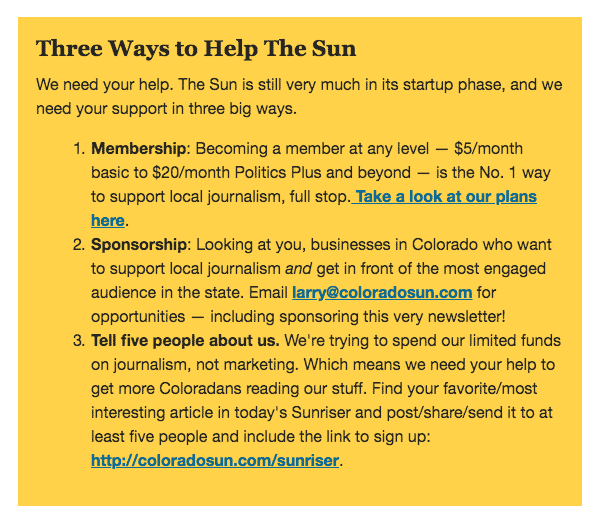
Text of the screenshot above. Links have been removed.
Three Ways to Help The Sun
We need your help. The Sun is still very much in its startup phase, and we need your support in three big ways.
- Membership: Becoming a member at any level — $5/month basic to $20/month Politics Plus and beyond — is the No. 1 way to support local journalism, full stop. Take a look at our plans here.
- Sponsorship: Looking at you, businesses in Colorado who want to support local journalism and get in front of the most engaged audience in the state. Email larry@coloradosun.com for opportunities — including sponsoring this very newsletter!
- Tell five people about us. We’re trying to spend our limited funds on journalism, not marketing. This means we need your help to get more Coloradans reading our stuff. Find your favorite/most interesting article in today’s Sunriser and post/share/send it to at least five people and include the link to sign up: http://coloradosun.com/sunriser.
The formatting is helpful, too. Each item is numbered, bold, and includes a link. Tells you exactly what they want you to do. Disclosure: I supported the Colorado Sun’s Kickstarter campaign, although I am not a current member.
When Julia O’Malley was writing Anchorage Eats, the food newsletter for Anchorage Daily News, she signed off with a link to subscribe.

Text of the screenshot above. Links have been removed.
We’re working on blueberry curd and baked Alaska in the online test kitchen. Join us! And, if you don’t already, support local cooking and local news and subscribe to the ADN.

Text of the screenshot above. Highlighted areas are noted. Links have been removed.
(Know what makes a great gift? A digital subscription to ADN.com.)
Here’s hoping the holiday spirit finds you, despite all your grouchy tendencies.

Text of the screenshot above. Highlighted areas are noted. Links have been removed.
If you don’t already, support my Tang research and all local journalism and subscribe to the digital version of your local paper.
What I love is that each week, it shows some personality while tying back to the great work going into the newsletter. The Tang comment is a bit of an inside joke, referring to Julia trying to remember a Tang drink from her childhood.
The Texas Tribune does a solid job of connecting the dots. If you love the newsletter — you will know who you are — then show them with a donation.

Text of the screenshot above. Highlighted areas are noted. Links have been removed.
Love this newsletter? Show us with your donation.
Have a friend you think would love it, too? Send them here to sign up.
Show your readers what you want them to do
You need a plan for what you want people to do. Then you need to show them what you want them to do.
- If you want people to buy your product, sell it to them.
- If you want them to join your membership program, show them the benefits.
- If you want your newsletter subscribers to attend an event, invite them.
If that sounds like an oversimplification, think about how many notifications you get every day. Plus emails. Plus text messages. It’s a lot of information. People don’t know everything you think they know. Guidance helps.
The reader’s next step may be different for different newsletters. In most cases, it should be. The key is to be as clear as possible with the goals of your newsletter in the planning process. Be deliberate and specific about what outcomes you want from your newsletter.
The clearer you are, the easier it is to visualize the path from stranger to customer.
Don’t give bad email.
This is bad email. There are no notes on it because it lacks any useful information. It also doesn’t tell me what it wants me to do, or where to go.
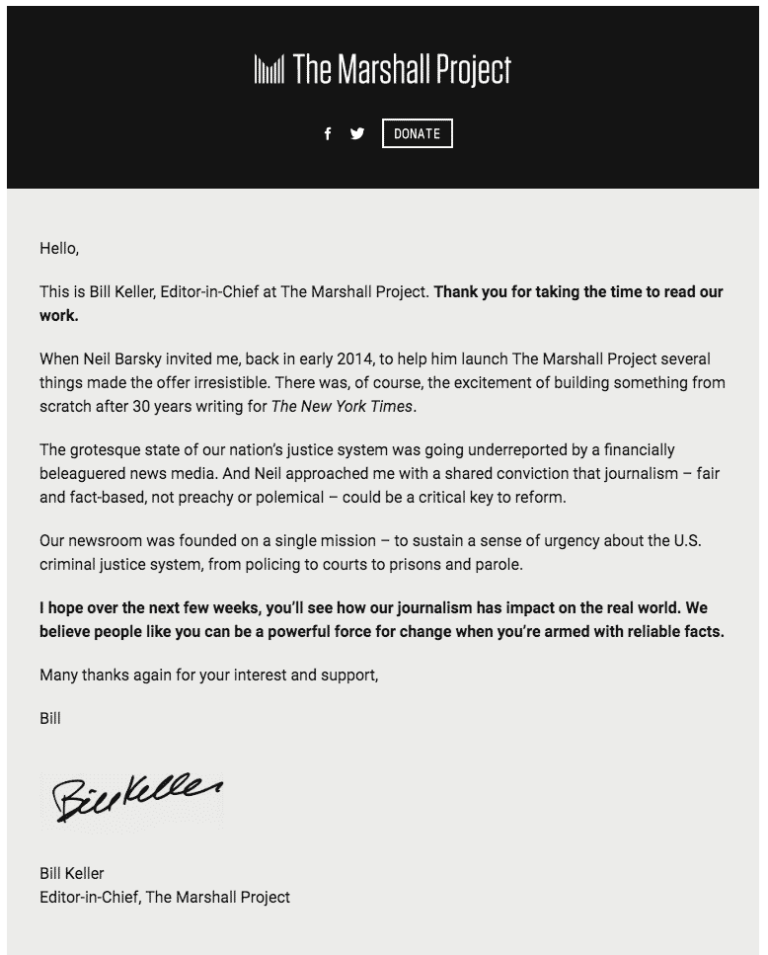
Text of the screenshot above. Links have been removed.
Hello,
This is Bill Keller, Editor-in-Chief at The Marshall Project. Thank you for taking the time to read our work.
When Neil Barsky invited me, back in early 2014, to help him launch The Marshall Project several things made the offer irresistible. There was, of course, the excitement of building something from scratch after 30 years writing for The New York Times.
The grotesque state of our nation’s justice system was going underreported by a financially beleaguered news media. And Neil approached me with a shared conviction that journalism – fair and fact-based, not preachy or polemical – could be a critical key to reform.
Our newsroom was founded on a single mission – to sustain a sense of urgency about the U.S. criminal justice system, from policing to courts to prisons and parole.
I hope over the next few weeks, you’ll see how our journalism has impact on the real world. We believe people like you can be a powerful force for change when you’re armed with reliable facts.
Many thanks again for your interest and support,
Bill
Bill Keller
Editor-in-Chief, The Marshall Project
The worst part is this email is a waste of my time. Emails this bad are telling me I can ignore emails from Bill Keller. They provide no content and no value.
Not to be outdone apparently, Marshall Project founder Neil Barsky send me this email almost two weeks later (there were some better ones in between).
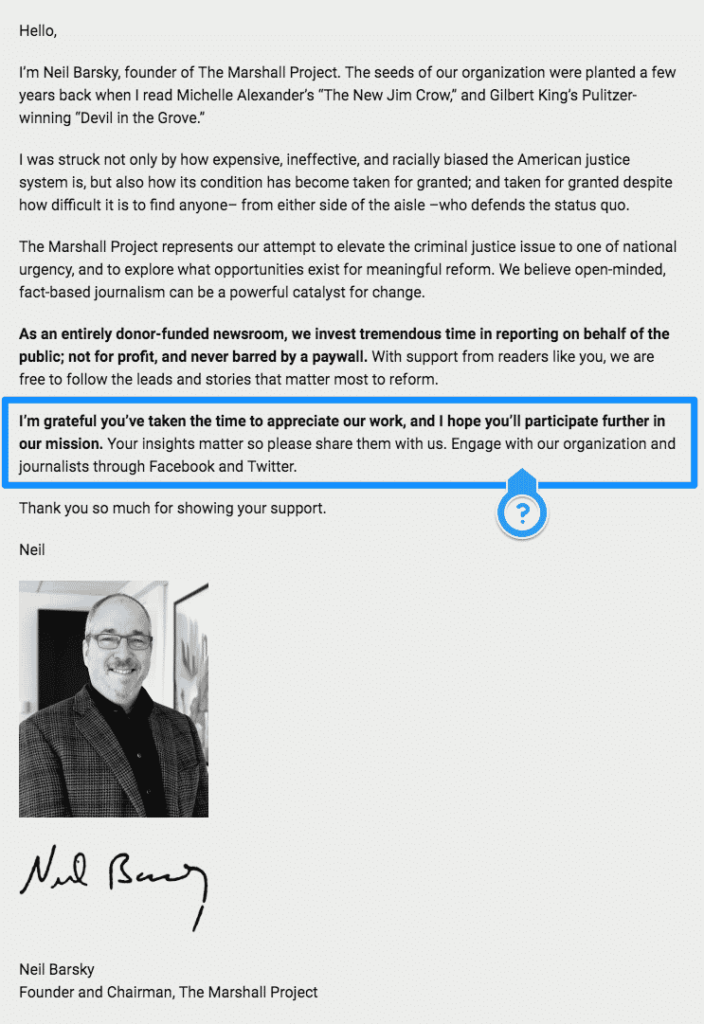
Text of the screenshot above. Highlighted areas are noted. Links have been removed.
Hello,
I’m Neil Barsky, founder of The Marshall Project. The seeds of our organization were planted a few years back when I read Michelle Alexander’s “The New Jim Crow,” and Gilbert King’s Pulitzer-winning “Devil in the Grove.”
I was struck not only by how expensive, ineffective, and racially biased the American justice system is, but also how its condition has become taken for granted; and taken for granted despite how difficult it is to find anyone– from either side of the aisle –who defends the status quo.
The Marshall Project represents our attempt to elevate the criminal justice issue to one of national urgency, and to explore what opportunities exist for meaningful reform. We believe open-minded, fact-based journalism can be a powerful catalyst for change.
As an entirely donor-funded newsroom, we invest tremendous time in reporting on behalf of the public; not for profit, and never barred by a paywall. With support from readers like you, we are free to follow the leads and stories that matter most to reform.
[Paragraph highlighted for commentary below]: I’m grateful you’ve taken the time to appreciate our work, and I hope you’ll participate further in our mission. Your insights matter so please share them with us. Engage with our organization and journalists through Facebook and Twitter.
Thank you so much for showing your support.
Neil
Neil Barsky
Founder and Chairman, The Marshall Project
Again, what do you want me to do? This email points out The Marshall Project is “entirely donor-funded”, but it doesn’t ask me for money.
This close-the-deal paragraph is especially odd. How do I “participate further” in your mission? I haven’t participated at all. Do you need money? Do I need to share something? Call my Governor? I have no idea.
This last sentence is a doozy. No one wants to “engage” with another person, much less an organization. Talk like a human, not a conference panelist. People may want to talk to journalists or ask them questions. Use familiar words.
The important thing to remember is that I’m not a normal reader. I read these and break them down to analyze how they work (or don’t). Normal readers won’t give this a half-second of extra thought. They will delete and forget you ever emailed.
Visualize the path from reader to customer
The most common visualization for how a stranger becomes a loyal customer is the purchasing funnel. If you’ve been to a conference lately or a webinar, you’ve heard of the funnel. Some people use a pipeline or a ladder.
No matter the shape, it’s all the same idea. In 1898, E. St. Elmo Lewis created the AIDA model. The letters in AIDA stand for Awareness, Interest, Desire, and Action. In each stage, the number of people decreases, so the Funnel is narrower at the bottom than at the top.
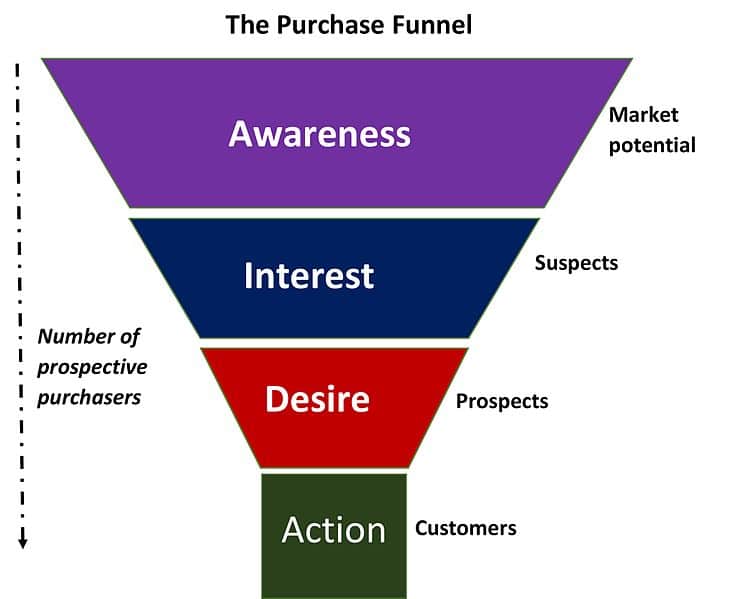
Funnels are useful for planning your strategy to get new readers and convert them to paying customers. Funnels can also be helping for defining newsletter segments so that you can personalize your emails to your audiences.
There’s one problem with funnels that fools even experienced marketers. Liquid moves through a funnel because of gravity. You don’t have to do anything, it just happens.
Customers don’t work that way.
Customers need to be persuaded to move to the next step. They aren’t whisked away by gravity. You have to guide them.
Give your potential customers a friendly nudge
Have you ever lined up a bunch of dominoes to trigger a chain reaction? If you spaced them too far apart, it didn’t work. And if you bumped your domino masterpiece too early, well…
Instead of a funnel, let’s try another visualization. Think of each step a person takes from total stranger to happy paying customer. Imagine each step as a standing domino. We have a series of steps like dominos standing next to one another.
The first domino needs a nudge to knock it over. If we set them upright, each domino falls forward. This creates a nudge for the next domino, which knocks it over. Like this:
People need a nudge to get from Awareness to Interest, another nudge to get from Interest to Decision, and so on. You have to provide the nudge, otherwise, people don’t know where you want them to go.
If you don’t nudge people, they are likely to stay right where they are. A few people will take the initiative to figure out how to give you money for your work, but most won’t.
There’s been a lot of ink spilled about subscription fatigue. I’m less concerned about that. You aren’t competing with the New York Times, and you aren’t competing with Netflix.
You’re competing against inertia.
Leverage your newsletter relationship to encourage reader revenue
24 of the 99 Newsletters didn’t mention how to support their work after I signed up. Never brought up how to give them money. Not through a paid subscription, not through a donation to nonprofits. Nothing.
19 of the 99 Newsletters included a button or ad, but no sales pitch.
5 of the 99 Newsletters mentioned how to support their work in the Welcome Email, but didn’t bring it up again.
That’s 48% of the 99 Newsletters that didn’t try to convert me from a free newsletter subscriber to a paying customer.
I’m shocked.
It’s damn hard to avoid intrusive subscription pop-ups and paywall reminders on news websites. But there is virtually no attempt to drive more readers to subscribe in the newsletters.
Longform newsletters are getting more popular. They spend 500-1000 words — or more — for each edition. Yet how many take a few sentences to nudge people to pay for the main product once a month?
A “subscribe” button ain’t gonna cut it. Mailchimp says Media & Publishing averages a 4.62% click rate. How many of those are on a Subscribe button rather than a story link?
If I’m dead wrong and you have numbers to prove it — reach out. I’m happy to share your story.
Be excellent to each other
ProPublica Illinois and Block Club Chicago partnered on a fantastic project analyzing parking ticket disparities around Chicago. Both newsrooms are nonprofits. Block Club is reader supported with a paywall, but ProPublica Illinois has no paywall. Look at how ProPublica shared the spotlight with their partners:
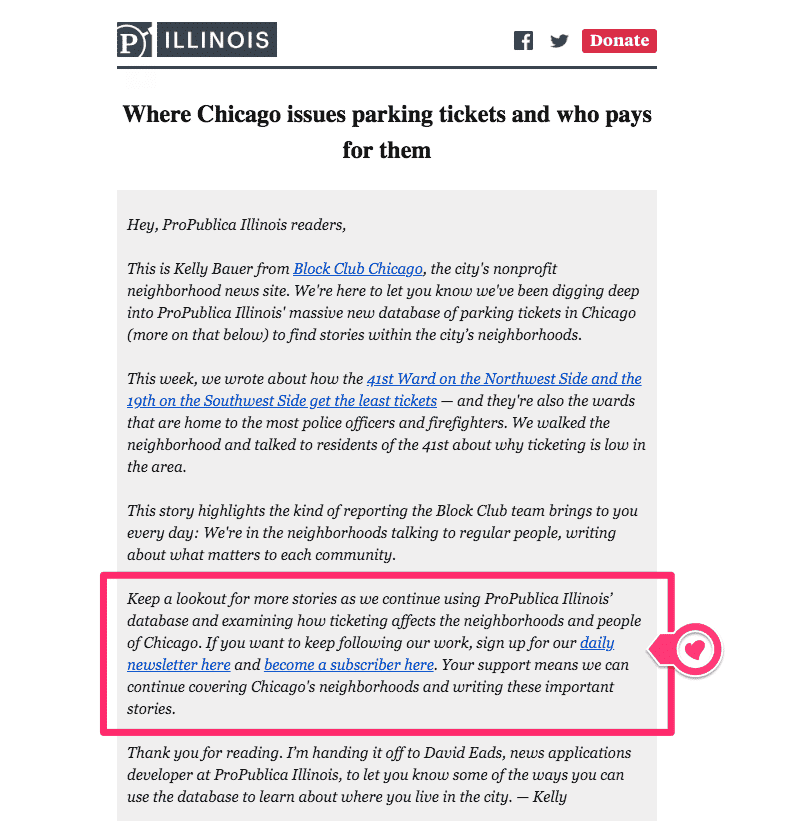
Text of the screenshot above. Highlighted areas are noted. Links have been removed.
Hey, ProPublica Illinois readers,
This is Kelly Bauer from Block Club Chicago, the city’s nonprofit neighborhood news site. We’re here to let you know we’ve been digging deep into ProPublica Illinois’ massive new database of parking tickets in Chicago (more on that below) to find stories within the city’s neighborhoods.
This week, we wrote about how the 41st Ward on the Northwest Side and the 19th on the Southwest Side get the least tickets — and they’re also the wards that are home to the most police officers and firefighters. We walked the neighborhood and talked to residents of the 41st about why ticketing is low in the area.
This story highlights the kind of reporting the Block Club team brings to you every day: We’re in the neighborhoods talking to regular people, writing about what matters to each community.
[Highlighted paragraph, because it is fantastic]: Keep a lookout for more stories as we continue using ProPublica Illinois’ database and examining how ticketing affects the neighborhoods and people of Chicago. If you want to keep following our work, sign up for our daily newsletter here and become a subscriber here. Your support means we can continue covering Chicago’s neighborhoods and writing these important stories.
Thank you for reading. I’m handing it off to David Eads, news applications developer at ProPublica Illinois, to let you know some of the ways you can use the database to learn about where you live in the city. — Kelly
Not only did a Block Club reporter write the intro, but ProPublica gave space to sell Block Club’s work! We need more collaboration and sharing like this. The more people pay for great journalism, the easier it gets to sell. Disclosure: I am a Block Club Chicago member. I worked at ProPublica in 2017.
Scolding people isn’t a strategy, and it won’t get people to pay for journalism.
One last important point. Scolding people who don’t pay isn’t selling. Scolding people who question why they should pay isn’t a strategy.
It might make you feel better for a fleeting moment. But it’s going to hurt you in the long run.
Do Costco servers with free samples scold customers who don’t buy the product they are promoting? Of course not. They are there to promote and educate people about the product. It’s an introduction. The first step in a potential new relationship.
If people handing out meatballs on toothpicks aren’t scolding people who don’t buy a box, then why are we scolding people who don’t pay for articles we share?
Should we scold a person who had to work and missed a zoning meeting, so they rely on our coverage?
Should we scold people who go to the library and read the articles there — for free?
Should we scold the obnoxious daily Facebook commenter who complains about the paywall? Absolutely not.
Maybe he’s an asshole. But maybe he’s broke. Or poor.
Even if he really is an asshole, don’t scold. There are too many people reading that don’t know he does this every week he annoys you. It’s likely they will see you as out of touch or rude.
This is an opportunity to sell your work. Nudge the lurkers and the frequent friendly commenters. And share where your work can be read for free — like the library. There are probably people who don’t know and are afraid to ask.
You may not get a new subscriber every time. But you’ll get more in the long run than if you scold people who complain.
Get more updates like this, and
unsubscribe anytime with no hassle
Featured image by Lachlan Donald.


